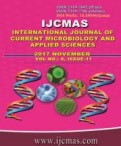


 National Academy of Agricultural Sciences (NAAS)
National Academy of Agricultural Sciences (NAAS)

|
PRINT ISSN : 2319-7692
Online ISSN : 2319-7706 Issues : 12 per year Publisher : Excellent Publishers Email : editorijcmas@gmail.com / submit@ijcmas.com Editor-in-chief: Dr.M.Prakash Index Copernicus ICV 2018: 95.39 NAAS RATING 2020: 5.38 |
Fungal infections of skin and its appendages are more prevalent in India due to favourable climatic conditions like temperature and humidity. Onychomycosis is chronic fungal infection of fingernails and toenails. A variety of fungi cause onychomycosis. Dermatophytes are predominant pathogens but yeasts and non dermatophyte moulds may also be implicated. Due to importance of high prevalence rate of onychomycosis this study was conducted. In the present study 100 patients suspected of onychomycosis were examined. Diagnosis of onychomycosis was based on the patient’s history, physical examination, microscopy and culture of nail specimens. Higher incidence was noted in males (71%) than females (29%). Distal lateral subungual onychomycosis (DLSO) was the commonest clinical pattern found in 69% of patients followed by total dystrophic onychomycosis (TDO) found in 17% cases. Direct microscopy of the nail clippings in 20% KOH solution was positive in 61% and culture was positive in 54% cases. The common etiological agent was dermatophytes (79.6% cases) followed by non dermatophyte moulds (11.1% cases) and yeasts (9.2% cases). Although onychomycosis is not life threatening, it can cause a significant negative impact on the quality of life of infected patients.
 |
 |
 |
 |
 |